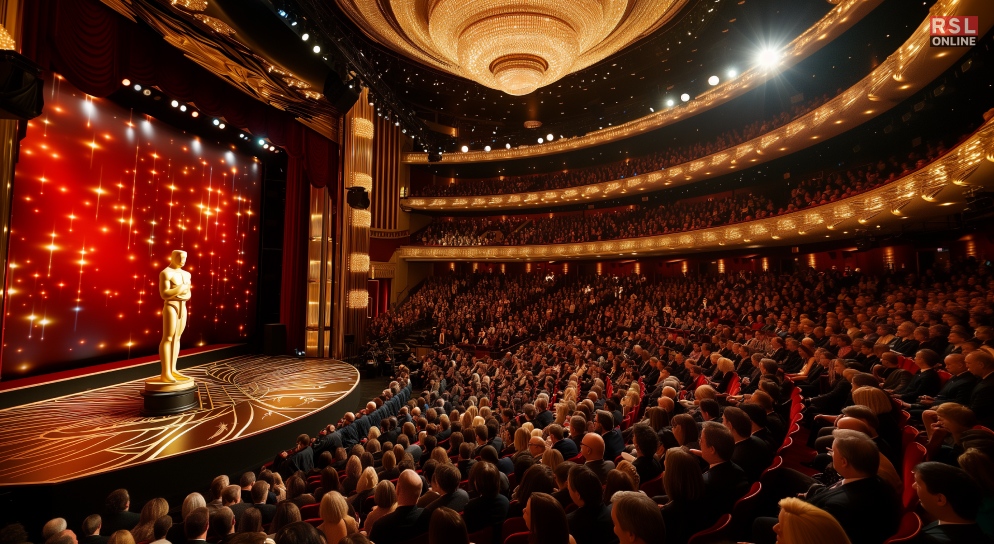The Oscar statue, also known as the Academy Award of Merit, is the most coveted and recognized trophy in the film industry.
Every year, the Oscar statue is awarded to the best films, performances, and achievements of the previous year, by the Academy of Motion Picture Arts and Sciences.
The Oscar trophy is a symbol of excellence, prestige, and glamour, and a dream of many filmmakers and actors.
But what is the Oscar statue made of, and who is it modeled after? Why is it called the Oscars, and what are the first words of the award categories? How did the Oscar trophy become a cultural icon, and is it still relevant and meaningful today?
In this article, I will explore the history, design, and significance of the Oscar award statue, and examine its role and impact in the film industry and society.
The Oscar Statue: Everything You Need to Know About It!

The Oscar statue was created in 1928 by Cedric Gibbons, the chief art director of MGM, and George Stanley, a Los Angeles sculptor.
Gibbons designed the statue on paper as a knight standing on a film reel, holding a crusader’s sword. Stanley sculpted the statue in clay, then cast it in bronze and gold. The statue was 13.5 inches tall and weighed 8.5 pounds.
The first Oscar trophy were presented at the Hollywood Roosevelt Hotel on May 16, 1929. The event was attended by about 270 people and lasted for 15 minutes.
The winners were announced three months in advance, and received their statues from Douglas Fairbanks, the president of the Academy. Actor Emil Jannings got the first Oscar statue for The Way of All Flesh and The Last Command.
The Oscar statue has remained largely unchanged since its inception, except for some minor modifications and refinements.
The only major change was in 1945, when the film reel was altered to include five spokes, representing the original five branches of the Academy. These were the actors, the directors, the producers, the technicians, and the writers.
The Oscar statue is now made of britannium, a pewter-like alloy, and plated in copper, nickel, silver, and 24-karat gold. The Oscar award statue is now manufactured by Polich Tallix, a New York-based foundry, and takes about three months to produce.
The Design of the Oscar Statue

The Oscar statue is a masterpiece of Art Deco design, a style that emerged in the 1920s and 1930s, and influenced architecture, fashion, and art. Art Deco was characterized by geometric shapes, streamlined forms, and metallic colors, and reflected the modernity, elegance, and sophistication of the era.
The statue is a perfect example of Art Deco design, as it combines the elements of geometry, symmetry, and simplicity. The Oscar statue is composed of a circular base, a cylindrical film reel, a rectangular sword, and a human figure.
It is symmetrical, as it can be divided into two equal halves along the vertical axis. The Oscar statue is simple, as it has no facial features, clothing, or accessories, and only depicts the essential contours of the body.
This is also a representation of the film industry, and its values and ideals. The Oscar statue is a knight, a symbol of honor, courage, and loyalty. This award statue holds a sword, a symbol of power, justice, and protection.
The Oscar award is standing on a film reel, a symbol of art, creativity, and innovation. The Oscar statue is made of gold, a symbol of excellence, prestige, and glamour.
The Name of the Oscar Statue

The Oscar statue is officially known as the Academy Award of Merit, but it is more popularly and colloquially known as the Oscar. The origin of the name Oscar is unclear, and there are several theories and stories behind it.
One common story is that the name Oscar was coined by Margaret Herrick, the librarian and later the Academy’s executive director. According to this story, Herrick saw the statue for the first time in 1931 and exclaimed that it looked like her uncle, whose name was Oscar. The name Oscar then spread among the staff and members of the Academy and became official.
Another story is that the name Oscar was given by Bette Davis, the actress and the president of the Academy. According to this story, Davis named the statue Oscar after her first husband, Harmon Oscar Nelson, because the statue’s rear end reminded her of his. The name Oscar then became popular among the press and the public and was adopted by the Academy.
A third story is that the name Oscar was derived from a joke by Walt Disney, the animator and producer. According to this story, Disney thanked the Academy for his Oscar in 1932, and added that he was glad that it was not a “Lewie”, a reference to Louis B. Mayer, the head of MGM and the founder of the Academy. The name Oscar then became a humorous contrast to the name Lewie and was embraced by the Academy.
The Significance of the Oscar Statue

The Oscar statue is more than just a trophy, it is a cultural icon. The statue symbolizes the film industry and its achievements and contributions to the world’s art and entertainment. The Oscar trophy is also a symbol of the American culture, and its values and aspirations of excellence, diversity, and innovation.
It is a source of pride and prestige for the filmmakers and actors who receive it, and a source of inspiration and admiration for the audiences who watch it. The Oscar statue is a recognition of the talent, hard work, and passion of the people who make and star in the films, and a celebration of the stories, emotions, and messages that the films convey.
The statue also catalyzes change and progress in the film industry and society. The Oscar award statue can influence the trends and tastes of the film market and the careers and opportunities of the filmmakers and actors. The Oscar statue can also reflect and challenge the issues and values of society and the representation and inclusion of diverse and marginalized groups.
The Role and Impact of the Oscar Statue

The Oscar statue is a cultural icon, but is it also a cliché? The Oscar statue has been praised and criticized, loved and hated, revered and mocked by the filmmakers, actors, critics, and fans, for various reasons and perspectives.
Some of the praises and criticisms of the Oscar statue are:
1. The Oscar Statue is a measure of quality and merit, but it is also a product of politics and bias.
The Oscar statue is awarded by the members of the Academy, who are supposed to vote based on their professional judgment and artistic appreciation. However, the Oscar statue can also be influenced by the campaigns and lobbies of the studios and the agents, and the preferences and prejudices of the voters, who may favor certain genres, styles, or themes over others, or overlook some films or performances that deserve recognition.
2. The Oscar statue recognizes diversity and inclusion but also reflects discrimination and exclusion.
The Oscar statue is awarded to the films and performances that represent and celebrate the diversity and inclusion of the film industry and society, such as the films and performances of women, people of color, and international artists. However, the Oscar statue can also reflect the discrimination and exclusion that exist in the film industry and society, such as the lack of representation and recognition of the films and performances of women, people of color, and international artists, or the stereotyping and marginalization of some groups or issues.
3. The Oscar statue is a celebration of art and entertainment, but it is also a manifestation of commerce and hype.
The Oscar statue is awarded to the films and performances that showcase the art and entertainment of the film industry, such as the films and performances that are original, creative, and innovative, or that are emotionally engaging and inspiring. However, the Oscar statue can also manifest the commerce and hype of the film industry, such as the films and performances that are driven by the box office, the ratings, or the awards, or that are overrated or overexposed by the media and the public.
Bonus: Things You Should Know About the Academy Awards!

Now that you know almost all the things about Oscar statue, you might be thinking “Oh, this is all that they’ve got!”
But, no!
Here are some of the things that you should be looking at if you are curious about the Oscars in general:
1. Where are the Academy Awards Held Every Year?

The very first Academy Awards ceremony still hosts many film events. The ceremony was a private banquett. Only 270 people had attended, and the names of the winners were declared three months before. Emil Jannings was the first Oscar winner for his roles in The Last Command and The Way of All Flesh.
Since then, the Academy Awards have been held at various venues, such as the Ambassador Hotel, the Biltmore Hotel, the Shrine Auditorium, the Pantages Theatre, the Santa Monica Civic Auditorium, the Dorothy Chandler Pavilion, the Hollywood Palladium, and the Beverly Hilton Hotel. Some of these venues have hosted the ceremony multiple times, and some of them have historical or cultural significance for the film industry or society.
Since 2002, the Academy Awards have been held at the Dolby Theatre, formerly known as the Kodak Theatre, in Hollywood. The Dolby Theatre is a modern and spacious venue, with a seating capacity of about 3,400 people, and a state-of-the-art sound and lighting system. Dolby Theatre is located at the Hollywood and Highland Center, a shopping and entertainment complex that also features the TCL Chinese Theatre, the El Capitan Theatre, and the Hollywood Walk of Fame.
The Dolby Theatre is also a place where many memorable and historic moments have happened, such as the first Oscar win for a Black woman in a leading role (Halle Berry in 2002), the first Oscar win for a non-English language film in the Best Picture category (Parasite in 2020), and the first Oscar ceremony during a global pandemic (in 2021).
2. Where can you see the Academy Awards this year?

The Academy Awards are the most anticipated and watched event in the film industry, and you don’t want to miss it. Whether you are a film lover, a casual fan, or a first-time viewer, you can see the Academy Awards this year in various ways. The most popular one of them is to watch them online live.
You can watch the Academy Awards live on ABC, the official broadcaster of the ceremony, on Sunday, March 10, 2024, at 8 p.m. ET/5 p.m. PT. You can also watch the Academy Awards live on the official Oscars website or app, or on other platforms and services that offer live TV, such as AT&T TV, Hulu Live TV, YouTube TV, and Fubo TV. You may need a subscription or a free trial to access some of these options.
Wrapping It Up!
The Oscar statue is a cultural icon and a cliché, depending on how you look at it. It is a symbol of the film industry and the American culture, and a source of pride, prestige, inspiration, and admiration for the filmmakers, actors, and audiences.
It is also a product of the politics and bias, a reflection of the discrimination and exclusion, and a manifestation of the commerce and hype of the film industry and society.
The Oscar statue is a complex and controversial trophy, that has a rich and fascinating history, design, and significance, and that plays a significant and influential role and impact in the film industry and society.
Read Also:




























